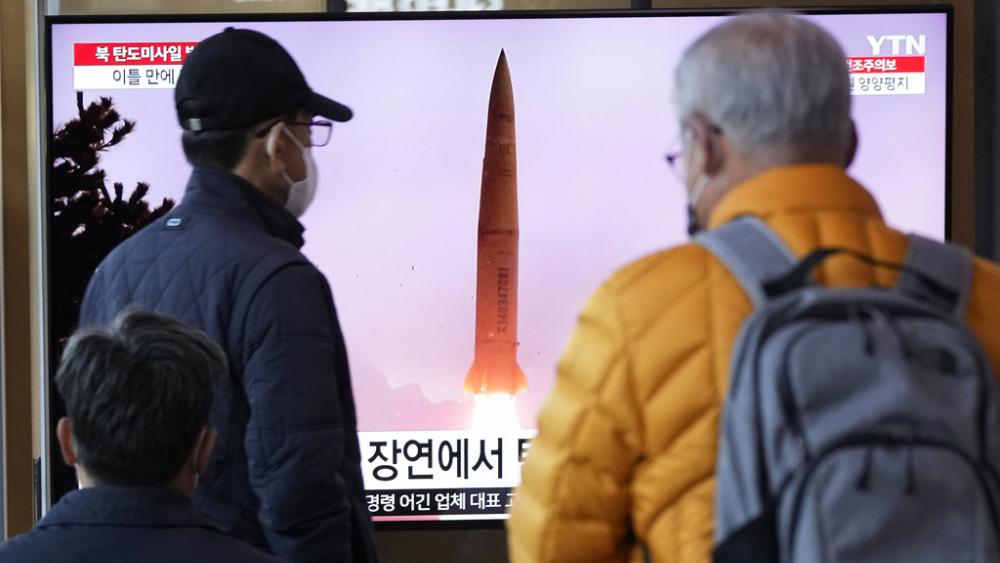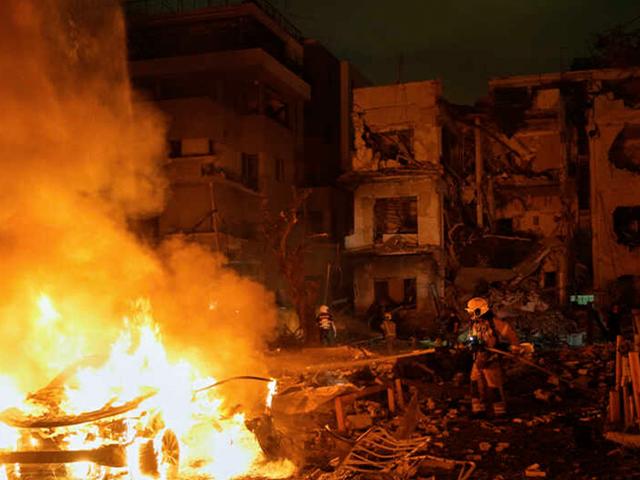SEOUL, South Korea (AP) — North Korea test-launched an intercontinental ballistic missile Thursday just hours before the leaders of South Korea and Japan were to meet at a Tokyo summit expected to be overshadowed by North Korean nuclear threats.
The North’s first ICBM test in a month and third weapons test this week also comes as South Korean and U.S. troops continue joint military exercises that Pyongyang considers a rehearsal to invade.
The missile flew about 1,000 kilometers (620 miles) with a maximum altitude of 6,000 kilometers (3,730 miles) during the 70-minute flight, according to South Korean and Japanese assessments. That’s similar to the flight details from a February launch of another ICBM, which experts said demonstrated a potential range to reach deep into the U.S. mainland.
The missile fell in the waters between the Korean Peninsula and Japan after being launched on a steep trajectory, apparently to avoid neighboring countries. Japan said the missile landed outside its exclusive economic zone and that there were no reports of damage of ships and aircraft.
North Korea has yet to test ICBMs on a standard trajectory, but it has repeatedly claimed it possesses functioning nuclear missiles. Some foreign experts still doubt the North has mastered the technologies needed to build warheads small enough to be placed on those missiles and protect the warheads during atmospheric reentry.
U.S. National Security Council spokesperson Adrienne Watson said Washington will take all necessary measures to ensure the security of the American homeland and its allies South Korea and Japan. She said the launch “needlessly raises tensions and risks destabilizing the security situation in the region.”
Before heading Tokyo for a summit with Japanese Prime Minister Fumio Kishida, South Korean President Yoon Suk Yeol said, “North Korea’s reckless provocations will pay the clear price.”
During an emergency security meeting on the North Korean launch, Yoon instructed the South Korean military to thoroughly proceed with its ongoing exercises with U.S. forces, conduct some of the planned joint drills in an intensive manner and strengthen Seoul-Washington-Tokyo security cooperation, according to Yoon’s office.
In Tokyo, Kishida said: “We must further strengthen cooperation among the allies and like-minded countries.”
The Yoon-Kishida summit set for Thursday afternoon was arranged after Yoon’s government last week took a major step toward repairing bilateral ties strained by Japan’s 1910-45 colonial rule of the Korean Peninsula. The South Korean plan — to use local funds to compensate some of the colonial-era forced labor victims without contributions from Japanese companies that employed them — has met fierce domestic opposition, but it reflects Yoon’s resolve to boost Seoul-Tokyo-Washington security cooperation.
“Yoon’s Tokyo trip faced domestic opposition for allegedly rushing historical reconciliation in the interest of improving relations with Japan," said Leif-Eric Easley, a professor at Ewha University in Seoul. “North Korea’s ICBM test on the day of the Yoon-Kishida summit may have been intended to aggravate those politics but instead makes patently clear the need for deepening security cooperation among U.S. allies.”
President Joe Biden welcomed the South Korean plan as a major step toward enhancing the partnership between two of America’s closest allies, which together host about 80,000 U.S. troops. The United States has sought stronger alliances in Asia to deal with a Chinese rise and North Korean threats.
North Korea’s pursuit of an expanded nuclear arsenal has pushed South Korea and Japan to seek to boost their security partnerships with the United States, as both countries are within striking distance of North Korean nuclear-capable missiles. Last October, North Korea fired an intermediate-range missile over northern Japan, forcing communities there to issue evacuation alerts and halt trains.
Under Kishida, Tokyo has also made a major break from its post-World War II principle of self-defense only, adopting a new national security strategy in December that includes the goals of acquiring preemptive strike capabilities and cruise missiles to counter growing threats from North Korea, China and Russia.
The North’s ongoing aggressive run of weapons tests has been widely expected. Leader Kim Jong Un last week ordered his military to be ready to repel what he called “frantic war preparations moves” by his country’s rivals, referring to large joint drills between the U.S. and South Korea that began Monday.
North Korea has long argued that U.S.-South Korean military drills are proof of their hostile policies against North Korea, though Washington and Seoul say they have no intentions of invading the North. Many experts say North Korea uses its rivals’ drills as a pretext to boost its nuclear capability to pressure the United States to make concessions like the relaxing of international sanctions.
After conducting a record number of missile tests last year, North Korea has extended its testing activities this year, including the Feb. 18 launch of its Hwasong-15 ICBM. After that launch, North Korea said the test was meant to further bolster its “fatal” nuclear attack capacity against its rivals.
The Hwasong-15 is one of the North’s three ICBMs, which all use liquid propellants that require pre-launch injections. Kim has vowed to build solid-propellant missiles, which are more mobile and harder to detect before their launches because their fuels are already loaded inside.
South Korea’s military said Thursday's missile launch occurred in Pyongyang’s Sunan neighborhood, home to its international airport. It is a major testing site where the North has launched most of its recent ICBM tests.
Pyongyang also this week fired cruise missiles from a submarine and sent short-range ballistic missiles across its territory into its eastern sea. Last week, North Korea fired at least six short-range ballistic missiles from a western coastal area in an exercise that its state media called a simulated attack on an unspecified South Korean airfield.
The ongoing U.S.-South Korean drills are scheduled to continue until March 23 and include computer simulations and live-fire field exercises. Experts had expected North Korea to further ramp up its testing activities during the drills.
The top nuclear envoys of Seoul, Washington and Tokyo discussed the North’s ICBM launch over the phone and agreed to coordinate to elicit a unified international response toward the North’s weapons activities, according to Seoul’s Foreign Ministry.
Did you know?
God is everywhere—even in the news. That’s why we view every news story through the lens of faith. We are committed to delivering quality independent Christian journalism you can trust. But it takes a lot of hard work, time, and money to do what we do. Help us continue to be a voice for truth in the media by supporting CBN News for as little as $1.










 Subscribe
Subscribe Follow
Follow CBN.com
CBN.com
 Support CBN News
Support CBN News







